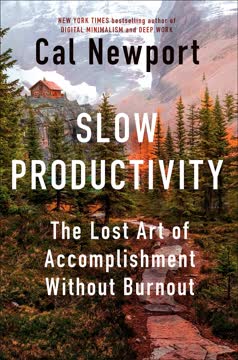Key Takeaways
1. The Pomodoro Technique: A Simple Yet Powerful Time Management Method
"The aim of the Pomodoro Technique is to provide a simple tool/process for improving productivity (your own and that of your team)."
Origin and core principle. The Pomodoro Technique, developed by Francesco Cirillo in the late 1980s, is a time management method that uses a timer to break work into intervals, traditionally 25 minutes in length, separated by short breaks. This technique is named after the tomato-shaped kitchen timer Cirillo used as a university student.
Key benefits:
- Alleviates anxiety linked to time pressure
- Enhances focus and concentration
- Increases awareness of decisions and time usage
- Boosts motivation and maintains it consistently
- Improves work or study processes
- Strengthens determination in complex situations
The simplicity of the Pomodoro Technique is its greatest strength, making it easy to implement and adapt to various tasks and work environments.
2. Embrace the 25-Minute Work Sprint and 5-Minute Break Rhythm
"A Pomodoro can't be interrupted: It marks 25 minutes of pure work."
The Pomodoro structure. A standard Pomodoro consists of 25 minutes of focused work followed by a 5-minute break. After completing four Pomodoros, take a longer break of 15-30 minutes. This rhythm helps maintain high levels of concentration and prevents mental fatigue.
Implementing the technique:
- Choose a task to work on
- Set the timer for 25 minutes
- Work on the task until the timer rings
- Take a short 5-minute break
- Every four Pomodoros, take a longer break
The key is to respect the Pomodoro as an indivisible unit of time. If interrupted, the Pomodoro should be considered void and restarted. This practice reinforces the importance of focused work periods and helps in managing both internal and external interruptions effectively.
3. Master the Art of Dealing with Interruptions
"Inverting the dependency on interruptions and consequently making these interruptions depend on the Pomodoros into which we decide to slot them."
Types of interruptions:
- Internal (self-generated distractions)
- External (interruptions from others)
Strategies for managing interruptions:
- Write down the interruption
- Inform the interrupter that you're busy (if external)
- Schedule the interruption for later
- Continue with the current Pomodoro
By consciously deciding how to handle interruptions, you gain control over your time and attention. This practice helps in developing a more focused work environment and reduces the negative impact of constant disruptions on productivity.
The technique also introduces the concept of "informed others," where you communicate your time management strategy to colleagues, thereby reducing unnecessary interruptions and fostering a more productive work culture.
4. Estimate and Track Your Efforts for Continuous Improvement
"Learning to estimate is essential to being effective."
Importance of estimation. The Pomodoro Technique emphasizes the importance of estimating the number of Pomodoros required for tasks. This practice helps in better planning and provides a tangible measure of productivity.
Tracking process:
- Before starting work, estimate the number of Pomodoros needed for each task
- Record actual Pomodoros used
- Analyze the difference between estimated and actual Pomodoros
- Use this data to improve future estimations
As you consistently apply this process, your ability to estimate task durations improves. This leads to more accurate planning and a better understanding of your work patterns. The technique also encourages breaking down larger tasks into smaller, more manageable chunks, typically not exceeding 5-7 Pomodoros.
5. Enhance Focus and Productivity Through Timed Work Sessions
"Experience shows that the Pomodoro Technique works best with 30-minute periods."
Optimal Pomodoro duration. While the traditional Pomodoro is 25 minutes, the technique allows for flexibility. The ideal duration should balance two factors:
- Being long enough to achieve meaningful progress
- Short enough to maintain high focus and avoid mental fatigue
Benefits of timed sessions:
- Creates a sense of urgency, promoting focus
- Provides clear start and end points for tasks
- Allows for regular assessment of progress
- Encourages breaking down complex tasks into manageable parts
The timed nature of Pomodoros also helps in developing a better sense of time passing, leading to improved time management skills. Many practitioners report being able to intuitively feel when a Pomodoro is about to end, indicating an enhanced awareness of time.
6. Adapt the Pomodoro Technique for Team Collaboration
"Each microteam has and manages its own Pomodoro. The rule is One Microteam, One Pomodoro."
Team application principles:
- Use microteams (small groups working on specific tasks)
- Each microteam manages its own Pomodoro
- Implement practices like Pomodoro Rotations and the Counter
Key team practices:
- Pomodoro Rotations: Team members switch between microteams periodically
- The Counter: Designate a team to handle interruptions, allowing others to focus
- The Ram: Use collective intelligence to solve complex problems without disrupting flow
These adaptations allow teams to benefit from the Pomodoro Technique while maintaining flexibility and addressing common challenges in collaborative environments. The technique can help reduce unnecessary meetings, protect the team from interruptions, and improve overall productivity.
7. Overcome Procrastination and Anxiety with Structured Time Blocks
"The next Pomodoro will go better."
Addressing procrastination. The Pomodoro Technique is particularly effective in combating procrastination by breaking work into small, manageable chunks. This approach makes it easier to start tasks and maintain momentum.
Strategies for overcoming work anxiety:
- Focus on one Pomodoro at a time, not the entire workload
- Use the first Pomodoro of the day for planning and prioritization
- Embrace the idea that each Pomodoro is an opportunity for improvement
The technique's structure provides a framework that can alleviate anxiety related to large projects or looming deadlines. By focusing on the current Pomodoro, users can avoid feeling overwhelmed by the totality of their workload.
8. Develop a Healthier Relationship with Time and Work
"A different awareness of the passage of time seems to lead Pomodoro users to a higher level of concentration in performing the activity at hand."
Shifting time perception. The Pomodoro Technique helps users develop a new relationship with time, viewing it as a finite resource to be used intentionally rather than an endless stream of moments.
Benefits of this new perspective:
- Reduced anxiety about time passing
- Increased appreciation for the present moment
- Better work-life balance through clear delineation of work and break times
- Enhanced ability to concentrate and enter flow states
By consistently applying the technique, users often report a change in how they perceive and interact with time. This shift can lead to a more balanced and satisfying approach to work and personal time management.
Last updated:
FAQ
What's "The Pomodoro Technique" about?
- Time-Management System: "The Pomodoro Technique" by Francesco Cirillo is a time-management method designed to improve productivity by breaking work into intervals, traditionally 25 minutes in length, separated by short breaks.
- Origins and Development: The technique was developed in the late 1980s and has been refined over the years to help individuals and teams manage time more effectively.
- Focus on Concentration: It aims to enhance focus and concentration by cutting down on interruptions and using time as an ally rather than an enemy.
- Structured Approach: The book provides a structured approach to managing tasks, estimating effort, and setting up a timetable to achieve personal and team goals.
Why should I read "The Pomodoro Technique"?
- Improve Productivity: The book offers a simple yet effective method to boost productivity by managing time efficiently.
- Reduce Anxiety: It helps alleviate anxiety linked to time pressure by providing a clear framework for task completion.
- Enhance Focus: By minimizing interruptions, the technique enhances focus and concentration, leading to better work quality.
- Personal and Team Benefits: Whether you're working alone or in a team, the technique can be adapted to suit different needs and improve overall performance.
What are the key takeaways of "The Pomodoro Technique"?
- Time as an Ally: The technique teaches you to use time as a valuable ally to accomplish tasks effectively.
- Structured Work Intervals: Work is divided into 25-minute intervals called Pomodoros, followed by short breaks to maintain high levels of concentration.
- Interruptions Management: It provides strategies to handle both internal and external interruptions, ensuring continuous workflow.
- Incremental Improvement: The method encourages continual self-observation and feedback to refine work processes and improve productivity over time.
How does the Pomodoro Technique work?
- 25-Minute Work Sessions: Set a timer for 25 minutes and focus on a single task until the timer rings.
- Short Breaks: After each Pomodoro, take a 3-5 minute break to rest and recharge.
- Longer Breaks: After completing four Pomodoros, take a longer break of 15-30 minutes to relax and reflect.
- Task Management: Use tools like the To Do Today Sheet and Activity Inventory Sheet to plan and track tasks.
What are the goals of the Pomodoro Technique?
- Alleviate Anxiety: Reduce anxiety related to time pressure by providing a structured approach to task management.
- Enhance Focus: Improve focus and concentration by minimizing interruptions and distractions.
- Boost Motivation: Maintain consistent motivation by setting clear goals and achieving them incrementally.
- Improve Estimation: Refine the process of estimating effort required for tasks, leading to better planning and execution.
How can the Pomodoro Technique be applied to teams?
- Microteams Concept: Teams can be divided into microteams, each managing its own Pomodoro to maintain flexibility and focus.
- Shared Timetable: A team timetable can be used to schedule shared breaks and meetings, ensuring coordination without disrupting individual Pomodoros.
- Adapted Tools: The technique's tools, like the To Do Today Sheet, can be adapted for team use, with modifications to track collective efforts.
- Advanced Practices: Practices like Pomodoro Rotations and the Pomodoro Hackathon can be implemented to enhance team collaboration and problem-solving.
What are some advanced practices for teams using the Pomodoro Technique?
- Pomodoro Rotations: Team members switch places between microteams to share knowledge and improve skills.
- Snap Your Pomodoro: Take photos of completed tasks to create a visual timeline and simplify recording.
- Practice of the Counter: Designate a team to handle external interruptions, allowing others to focus on their tasks.
- Pomodoro Hackathon: Organize focused sessions to tackle complex problems collectively and generate innovative solutions.
What are the basic assumptions of the Pomodoro Technique?
- Different Perception of Time: The technique encourages a new way of seeing time, focusing on the present rather than the abstract concept of becoming.
- Mind Utilization: It promotes better use of the mind by enhancing clarity, focus, and learning.
- Simple Tools: The technique relies on easy-to-use, unobtrusive tools to reduce complexity and maintain continuity.
How does the Pomodoro Technique help with interruptions?
- Internal Interruptions: Acknowledge and record internal interruptions, then decide whether to address them later or intensify focus to complete the Pomodoro.
- External Interruptions: Use the Inform, Negotiate, Call Back Strategy to manage external interruptions without disrupting the Pomodoro.
- Systematic Interruptions: Allocate specific Pomodoros for handling organizational tasks and interruptions, reducing their impact on productivity.
What are the benefits of using the Pomodoro Technique?
- Increased Productivity: By structuring work into focused intervals, the technique enhances productivity and task completion.
- Reduced Stress: It alleviates stress by providing a clear framework for managing time and tasks.
- Improved Estimation: Regular use of the technique improves the ability to estimate effort and time required for tasks.
- Enhanced Self-Observation: The technique encourages continual self-observation and feedback, leading to personal and professional growth.
What are some common challenges when starting the Pomodoro Technique?
- Ring Anxiety: Beginners may feel anxious about being controlled by the timer, but this usually subsides with practice.
- Internal Interruptions: Overcoming frequent internal interruptions requires discipline and gradual improvement.
- Adapting to Breaks: Some may struggle with taking regular breaks, but these are essential for maintaining focus and productivity.
- Initial Resistance: There may be resistance to changing existing work habits, but the benefits of the technique become apparent with consistent use.
What are the best quotes from "The Pomodoro Technique" and what do they mean?
- "Time is a greedy player who wins without cheating, every round!" - This quote highlights the relentless nature of time and the importance of managing it effectively.
- "The next Pomodoro will go better." - A reminder that each Pomodoro is an opportunity for improvement and learning, encouraging perseverance.
- "The Pomodoro is indivisible." - Emphasizes the importance of maintaining focus and not interrupting the 25-minute work interval.
- "Protect the Pomodoro." - A call to safeguard the work interval from interruptions, ensuring maximum productivity and concentration.
Review Summary
The Pomodoro Technique receives mixed reviews, with ratings ranging from 1 to 5 stars. Many readers find the time management method helpful for improving focus and productivity, especially for students and those with defined tasks. However, some criticize the book as boring, overly academic, or unnecessary for understanding the technique. Critics note that the method may not work well for those with frequent interruptions or unpredictable schedules. Several reviewers appreciate the simplicity of the technique but feel the book could be more concise.
Similar Books










Download PDF
Download EPUB
.epub digital book format is ideal for reading ebooks on phones, tablets, and e-readers.




